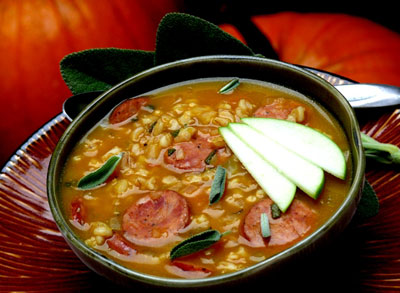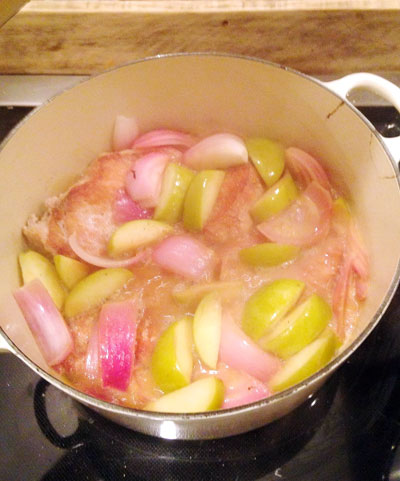 Soup weather has hit hard today, very rainy and gloomy all around. A good day for a fire and just hanging out.
Soup weather has hit hard today, very rainy and gloomy all around. A good day for a fire and just hanging out.
With Fall in full swing, some type of pumpkin soup seemed in order. This particular recipe is spicy (from the andouiile sausage) and a little bit sweet from the addition of maple syrup.
Served with fresh baked bread it was the perfect afternoon meal.
This soup is so easy to make, no other pictures were necessary. So enjoy the Fall season and hopefully you have soup weather too.
Fall
Fall
Fresh Fig Tart with Honey-Orange Custard
 For a long time, the closest I had ever come to what I thought was a real fig was the dried kind or Fig Newtons. It wasn't until a family friend gave us a fig tree that I learned figs are actually fresh before they are dried. Not only that, but I discovered that fresh figs were worlds apart from the dried ones. We weren't the only family with a fig tree in the neighborhood. Italian and Portuguese neighbors had them too. That's because figs are native to the Mediterranean region, where they have been revered since ancient and biblical times. You can't not find mention of it in ancient Greek and Roman texts and of course the Bible's creation story. What would we have done without fig leaves?
For a long time, the closest I had ever come to what I thought was a real fig was the dried kind or Fig Newtons. It wasn't until a family friend gave us a fig tree that I learned figs are actually fresh before they are dried. Not only that, but I discovered that fresh figs were worlds apart from the dried ones. We weren't the only family with a fig tree in the neighborhood. Italian and Portuguese neighbors had them too. That's because figs are native to the Mediterranean region, where they have been revered since ancient and biblical times. You can't not find mention of it in ancient Greek and Roman texts and of course the Bible's creation story. What would we have done without fig leaves?
For a number of years we were lucky to have our own Garden of Eden with a flourishing fig tree in the backyard. With much ingenuity we were able to keep it protected through many winters until one year it finally didn't survive the cold. But I can never forget how anxious I was all summer long as I waited for the figs to ripen. It seemed to me they always took so long. But fig season is late September, so I had to learn to be patient because there was nothing I could do to speed up mother nature.
Rosemary and Red Onion Apple Pork

Braising is probably next to roasting as my favorite cooking method for many things. Taking a meat and braising - not boiling it - is a delicate method to delicious cuts of meat! Gently infusing a gorgeous pork chop with apple cider is nothing short of divine. And this dish is easy and relativity quick! Wilt some kale in it and you've a one dish wonder!
I start with a Dutch oven and begin browning the pork chops on either side to form a slight crust. Salt and peppering the pork and high heat allows this. Searing them may be technically more apropos in culinary diction but y'all get me! Once the chops or even tenderloin are seared and crusted, I remove them from the pan onto a plate to rest.
Next, in the onion or two go to brown in the Dutch oven...No shock there folks! I use Mimi's adage, "butter for flavor, oil for temperature!" I really like to use red onions for this dish because they're color is so lovely - plus they caramelize fantastically! Brown the onions in some butter and oil and salt and pepper handsomely. This is the base of your meal y'all and adding salt at the end to me doesn't do salt and pepper their true justice of bringing out their companions' natural flavor.
Dessert Risotto with Wine Poached Figs
 One night last week Jeff came home from work and handed me a bag from his clinic. I thought, "Yes! More free anti-wrinkle cream!" (Having a dermatologist as a husband does have its advantages). When I peeked inside the bag, however, I discovered something even better than antioxidant cream: a dozen plump, brilliant green figs that were beginning to split from ripeness. "Wow! Where did you get the fresh figs?" I asked. "Adel gave them to me from the tree in her yard," he said.
One night last week Jeff came home from work and handed me a bag from his clinic. I thought, "Yes! More free anti-wrinkle cream!" (Having a dermatologist as a husband does have its advantages). When I peeked inside the bag, however, I discovered something even better than antioxidant cream: a dozen plump, brilliant green figs that were beginning to split from ripeness. "Wow! Where did you get the fresh figs?" I asked. "Adel gave them to me from the tree in her yard," he said.
Adel, who works with Jeff, told him, "Last year my tree produced three figs. One for me, one for my husband, and one for the birds." Fortunately she's having a bumper crop this season, and we're two of the lucky beneficiaries.
To celebrate fall's arrival, I'm sharing a recipe for Dessert Risotto with Wine Poached Figs. Arborio rice, which is used to make risotto, makes the most luxurious rice pudding imaginable: it's plump, tender, and creamy. Topping it with perfumed, wine-poached figs adds elegance and sweetness, resulting in a remarkably velvety, rich pudding.
Early Fall Bouquets
 With autumn beginning to wax, the garden is coming into its own, offering the bounty and plethora of blooms only an early fall garden can provide. Salvias, pentas, lantanas, Artemisia, and pomegranates are looking quite lovely this time of year for they have appreciated and endured the heat and now bestow their blossoms as trophies of survival from the heat of summer.
With autumn beginning to wax, the garden is coming into its own, offering the bounty and plethora of blooms only an early fall garden can provide. Salvias, pentas, lantanas, Artemisia, and pomegranates are looking quite lovely this time of year for they have appreciated and endured the heat and now bestow their blossoms as trophies of survival from the heat of summer.
One other great garden tiding that comes into play at the end of summer and into early fall is the flower spike of Liriope muscarri ‘Variegata’ or variegated monkey grass for the lay people. My Auburn professors knew I was from Middle Georgia because of my pronunciation of “liriope.” I pronounce it like leer-o-pee. While I’ve heard a myriad of other pronunciations, that is the way this Farmer says it. I digress.
The soft purple spikes of tiny florets make for a punch of color in small bouquets and even dry well…somewhat like lavender the herb. Other varieties of the Liriope genus such as ‘Big Blue’ also make for beautiful cut stem specimens and the berries, with their deepest amethyst to eggplant blackness.
They are lovely in holiday décor. Just imagine those dark berries with fir, pine, and magnolia in some blue and white cache pots or jardinières…quite lovely indeed. As September rolls into October, the Southern landscape yields these spikes along the aforementioned perennials and annuals for arrangements a plenty.
More Articles ...
Welcome to the new One for the Table ...
Our Home Page will be different each time you arrive.
We're sure you'll find something to pique your interest...


